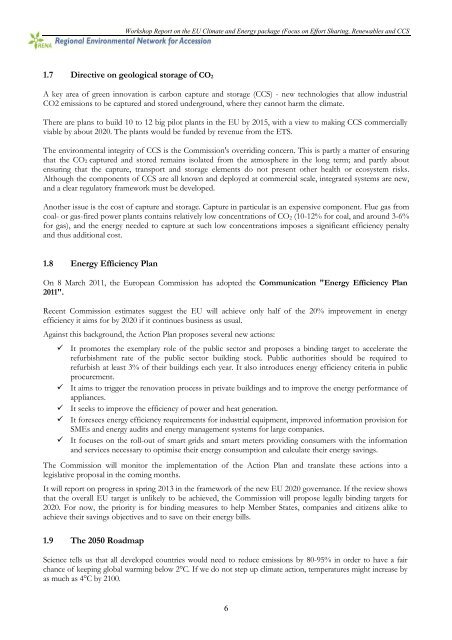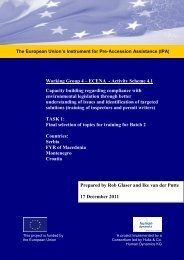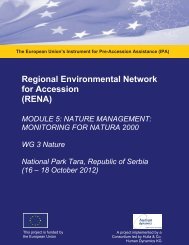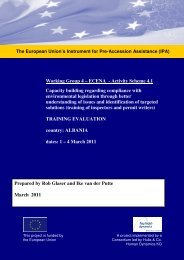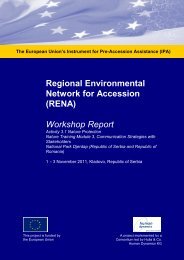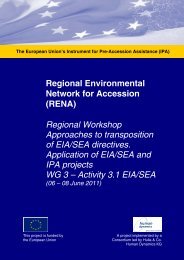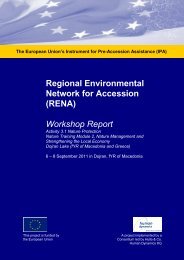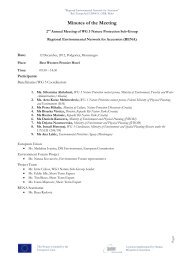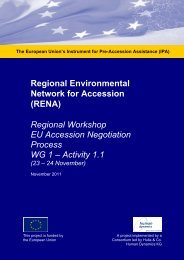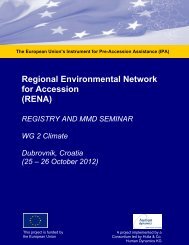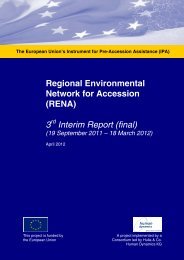Workshop Report March 2011 Budva ... - Renanetwork.org
Workshop Report March 2011 Budva ... - Renanetwork.org
Workshop Report March 2011 Budva ... - Renanetwork.org
- No tags were found...
You also want an ePaper? Increase the reach of your titles
YUMPU automatically turns print PDFs into web optimized ePapers that Google loves.
<strong>Workshop</strong> <strong>Report</strong> on the EU Climate and Energy package (Focus on Effort Sharing, Renewables and CCS1.7 Directive on geological storage of CO 2A key area of green innovation is carbon capture and storage (CCS) - new technologies that allow industrialCO2 emissions to be captured and stored underground, where they cannot harm the climate.There are plans to build 10 to 12 big pilot plants in the EU by 2015, with a view to making CCS commerciallyviable by about 2020. The plants would be funded by revenue from the ETS.The environmental integrity of CCS is the Commission's overriding concern. This is partly a matter of ensuringthat the CO 2 captured and stored remains isolated from the atmosphere in the long term; and partly aboutensuring that the capture, transport and storage elements do not present other health or ecosystem risks.Although the components of CCS are all known and deployed at commercial scale, integrated systems are new,and a clear regulatory framework must be developed.Another issue is the cost of capture and storage. Capture in particular is an expensive component. Flue gas fromcoal- or gas-fired power plants contains relatively low concentrations of CO 2 (10-12% for coal, and around 3-6%for gas), and the energy needed to capture at such low concentrations imposes a significant efficiency penaltyand thus additional cost.1.8 Energy Efficiency PlanOn 8 <strong>March</strong> <strong>2011</strong>, the European Commission has adopted the Communication "Energy Efficiency Plan<strong>2011</strong>".Recent Commission estimates suggest the EU will achieve only half of the 20% improvement in energyefficiency it aims for by 2020 if it continues business as usual.Against this background, the Action Plan proposes several new actions: It promotes the exemplary role of the public sector and proposes a binding target to accelerate therefurbishment rate of the public sector building stock. Public authorities should be required torefurbish at least 3% of their buildings each year. It also introduces energy efficiency criteria in publicprocurement. It aims to trigger the renovation process in private buildings and to improve the energy performance ofappliances. It seeks to improve the efficiency of power and heat generation. It foresees energy efficiency requirements for industrial equipment, improved information provision forSMEs and energy audits and energy management systems for large companies. It focuses on the roll-out of smart grids and smart meters providing consumers with the informationand services necessary to optimise their energy consumption and calculate their energy savings.The Commission will monitor the implementation of the Action Plan and translate these actions into alegislative proposal in the coming months.It will report on progress in spring 2013 in the framework of the new EU 2020 governance. If the review showsthat the overall EU target is unlikely to be achieved, the Commission will propose legally binding targets for2020. For now, the priority is for binding measures to help Member States, companies and citizens alike toachieve their savings objectives and to save on their energy bills.1.9 The 2050 RoadmapScience tells us that all developed countries would need to reduce emissions by 80-95% in order to have a fairchance of keeping global warming below 2°C. If we do not step up climate action, temperatures might increase byas much as 4°C by 2100.6


